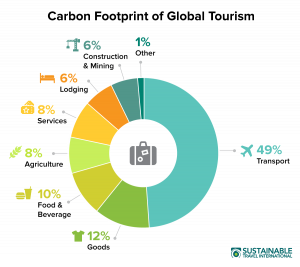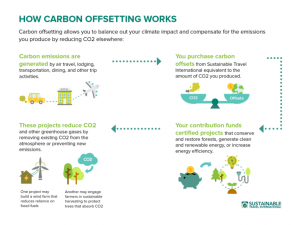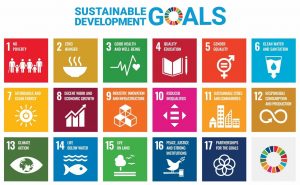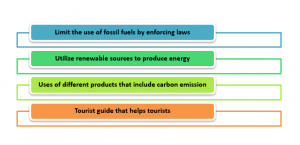TM6017 Tourism Futures Assignment Sample
Module Code And Title : TM6017 Tourism Futures Assignment Sample
Introduction
The contribution of the tourism industry to climate change is higher than any other industry and at the same time, it contributes to the emissions of carbon or other greenhouse gases which enhance global warming. This study demonstrates the current challenges confronted by the tourists of different places regarding the emissions of carbon in nature. It also evaluates the issues in the tourism industry for this major problem and how the sector is identifying the issues by using technology. The study also analyses the importance of carbon neutrality within the tourism sector by 2030 and its impact. The initiatives of the government, tourists, and tourism sector to enhance carbon neutrality will be demonstrated in this study as well.
Critical evaluation of current challenge through stakeholders’ perspective
Tourism contributes to carbon emissions near about 8% of the world and it influences climate change, and global warming of the whole world (sustainabletravel.org, 2022). There are different sectors such as flights, sovereign and lodging, and different other activities where tourism contributes to the carbon footprint. According to Cohen et al. (2017), transportation is one of the major segments for the tourism sector and travelers need to take different transportation systems in order to go from one place to another. On average cars, planes, boats, and trains generate the most carbon dioxide in the environment. In recent times transportation related carbon emissions in the tourism sector increased more than 60%, as people are traveling internationally more (sustainabletravel.org, 2022). Besides that, most of the accommodations are with air conditioning and heating to provide pleasant temperature to all the guests. As a result, those energy-intensive things emit carbon and contribute to the carbon emissions process of the areas (Higham et al. 2019). In the current time, tourists are more focused on taking modern services, hence the emissions of carbon dioxide become high in the big hotels and lodges.
 Figure 1: Carbon footprint global tourism (Source: sustainabletravel.org, 2022)
Figure 1: Carbon footprint global tourism (Source: sustainabletravel.org, 2022)
The construction process of the tourism industry is one of the significant reasons for high carbon emissions in the environment. As influenced by Dube and Nhamo (2021), different hotels, lodges, and guest houses are developing by cutting the forest, and removing carbon reach vegetation. As a result, the carbon absorbing power of some major places is getting low day by day and it is increasing the CO2 emissions in the atmosphere. The mangroves forests are able to absorb 4 times of carbon but the development of many tourist spots in the coastline areas are removing the mangroves forests as well. Several tourism industries are building resorts, beaches, different expensive hotels, and entertainment areas which are increasing the level of greenhouse gases globally (Lenzen et al. 2018). Food production in the tourism industry is also responsible for one-quarter of carbon emissions globally. Food waste is one of the main issues in the tourism sector and it influences the climate change issue across the globe as well. The food waste defines that all the production of food where unnecessary has contributed to the carbon emissions. The hotels of the UK produce 79,000 metric tons of food waste every year.
The global tourism industry will enhance the ‘carbon emissions near about 6.5Gt by 2025‘ (sustainabletravel.org, 2022). Hence, it is essential to focus on the overall carbon emissions challenges within the tourism industry and take a variety of initiatives to stop these issues more quickly. As opined by Lew (2018), the tourism sectors also need to take major initiatives to solve those issues and provide a carbon free environment to their tourists. Tourists from different places are confronting those issues while traveling in different places and it requires a quick solution to reduce the carbon emissions in the environment and control the climate change issue across the globe (Gössling and Scott, 2018). In addition, the development of sustainable tourism is effective to solve the global issue and manage the overall carbon emission issue within the tourism sector across the globe.
Assessment of carbon related issues in the tourism industry by using technology
Carbon emissions and climate change issues have become a global concern in recent times, many countries are facing challenges that enhance several problems regarding the environment. As stated by Scott et al. (2019), it has become a global consent to control the greenhouse gas emissions and solve the climate change issue more appropriately. The tourism industry is responsible for 8% of carbon emissions globally and the total amount of the greenhouse emissions by the industry has become 4.3 billion metric tons in 2018 (sustainabletravel.org, 2022). The global carbon footprint has increased to 3,9 to 4.5 Gt, between 2009 to 2013. Uses of different modern technology in different tourist spots are also one of the significant reasons for carbon emissions within nature (Kitamura et al. 2020). However, there are also some technologies which the tourism sector can use to solve the major challenges within their industry. Different methods are used to assess the carbon related issues within the tourism industry by using advanced technology.
 Figure 2: Carbon offsetting (Source: sustainabletravel.org, 2022)
Figure 2: Carbon offsetting (Source: sustainabletravel.org, 2022)
In 2020, the greenhouse gas emissions fell to 10.3% due to the sudden outbreak of Covid-19 as transportation was strictly prohibited in different parts of the world. As influenced by Higham and Font (2020), this is considered as one of the ‘largest drops of carbon emissions since the post-World War II era’. However, returning to normal life will develop the carbon emissions into nature and increase global warming. Hence, the tourism sector should apply some innovative technologies to identify the issues related to carbon emission and also control the problem within the tourism sector. Uses of proper techniques are crucial to slow down the emissions of carbon in different tourist places. ‘Climework’ is an air capture technology that uses a purifier for capturing atmospheric carbon and binding the carbon dioxide. The technology has the ability to capture the air from the atmosphere directly which includes the first commercial facility within the world (Dorta et al. 2021). Besides that, the captured carbon dioxide is recyclable and the grey emissions are less than 10%.
The lodges, hotels, and guest houses improve the air quality of the place and control carbon emissions from the tourism industry. ‘Terramera’ also innovates some technologies, which helps to solve the issues related to food waste and reduce atmospheric carbon dioxide. The food sectors from the tourism industry can use the innovative technologies of ‘Terramera’ to grow faster crops without any kinds of greenhouse gas emissions in the atmosphere. As opined by Lenzen et al. (2018), the tourism industry also can use CarbonCure to reduce carbon emissions by using advanced technology and providing recycled CO2 to improve the business operations of the tourism industry. Moreover, the use of those technologies may help the tourism industry to solve its carbon emissions issues in different tourism sectors and improve sustainability within the industry.
Importance of carbon neutrality within tourism sector by 2038
Carbon neutrality is important for the tourism sector, which helps the industry to improve the overall carbon footprint of different tourism sectors in a proper manner. It is essential for the sectors to focus on different sectors in a proper way to improve the carbon footprints of the tourism industry. As influenced by Gössling and Scott (2018), the enhancement of sustainability in the tourism sector helps to solve the challenges from the industry to develop business growth across the globe. Climate change is one of the main issues in recent times, and the tourism sector has one of the biggest contributions in the process. Development of the long-term sustainable management system within the tourism sector is essential to solve the carbon emissions issue within the organisation to manage the overall business condition effectively.
 Figure 3: Impact of sustainability in tourism (Source: Kitamura et al. 2020)
Figure 3: Impact of sustainability in tourism (Source: Kitamura et al. 2020)
Proper focus on carbon neutrality helps the organisation to solve global warming and climate change issues across the globe. Besides that, it enhances the condition of natural resources, forests, beaches, coastal areas, and other different parts of the world. The tourism industry needs to reduce the carbon emissions issues by 2038 to provide a more effective environment to the tourists and help them to enjoy the natural beauty of the planet (Kitamura et al. 2020). Besides that, respect for all socio-cultural perspectives is required to keep the beauty of that particular place which helps to manage the overall environment of the particular steps.
Reducing the luggage of the tourists helps to save four gallons of fuel per trip, which influences the control of carbon emissions. Besides that, eating local food while traveling can reduce carbon emissions as well by not ordering food from other places (Kitamura et al. 2020). In addition, the use of renewable energy is crucial to enhancing carbon neutrality by 2038. Besides that, the development of smart energy sensors is crucial to solving the issue of developing carbon neutrality in the tourism sector in a proper manner. Moreover, the development of those strategies will help to solve the carbon emission issue from the tourism sector and enhance sustainability across the globe.
The potential initiatives by the government, tourists, and tourism sectors to solve this issue
Initiatives by the Government
The governments of several countries have taken various initiatives to become carbon neutral by 2038. Certain key proposals have been taken by the government of Manchester such as establishing the “largest clean air zone” outskirt of London and others. Additionally, the government has also taken an initiative that includes phasing out of fossil fuels in the period of 20 years and panning to cut down uses of single-use plastics. According to Daimer et al. (2021), the government has also introduced an initiative to plant trees up to three million in the city region. Another initiative of the government suggests that citizens of the country must utilize walking and riding a bike instead of cars for short distances such as less than 1km.
In Greater Manchester, 30% of journeys cover less than a distance of 1km and people prefer to ride cars for this short route of journey. The UK has taken a few initiatives to control carbon emissions and is focusing to cut carbon emission by 78% by the year 2035. The government aims to reduce the emission of greenhouse gases by 68% in 2022 to provide a greener society. According to Xie et al. (2021), the UK government is also focusing on balancing carbon emissions with planting trees in different parts of the country. The government aims to balance between carbon offsets and carbon emissions through the process of reducing emissions of greenhouse gases. The UK government finds a way to reduce carbon emissions by utilizing natural sources that produce less carbon.
Initiatives by tourists
Tourists and citizens follow the rules of the governments in different countries to help respective governments to reduce carbon emissions. The tourists try to generate less plastic waste in the country and utilize sustainable products. They prefer products that are less harmful to the environment and support communities. As per the views of Gilardoni, (2020), tourists purchase products that assure fewer carbon emissions compared to others. They take initiative to contribute funding in the countries that are willing to reduce carbon emissions and emissions of greenhouse gases. They utilize different dustbins for dumping different types of waste and making the country clean. They have already taken the initiative to minimize the use of single-use plastic and use paper-based and fabric-based bags as a substitute for plastic bags.
Initiatives by tourism sectors
The tourism sector of the UK government has taken a few initiatives to make it a carbon-neutral country by 2038. The tourism sector includes multiple initiatives such as “Go lake travel” that is funded by the transport department. This initiative aims to change perspectives of visitors in Lake District emphasizing more sustainable methods of travel. Another initiative of the UK government in the tourism sector is “fix the fells” which includes the threat of erosion of footpaths in mountainous environments. According to Dorta Antequera et al. (2021), “Low carbon cottages” includes a scheme that aims to minimize carbon emissions as well as costs of business of traditional cottages. The “Love your lakes” initiative involves an urge to join efforts to remove toxic materials and toxic algae for improving water quality.
Recommendations
- Government can limit the use of fossil fuels by enforcing laws
The government of the UK and other countries must enforce laws to forcefully restrict the use of fossil fuels. Uses of fossil fuels emit more carbon than other energy sources as a result global warming is increasing day by day (Davies et al. 2020). To become a carbon-neutral country government of it must focus on the reduction of uses of fossil fuels.
- Government can utilize renewable sources to produce energy
The government of the UK must take initiative to emphasize the use of renewable sources for the production of energy. The government can also take the initiative to utilize the energy of waterfalls and dams to produce electricity as a substitute for fossil fuels. It can take another initiative to utilize the energy of wind with the help of windmills to produce electricity and the government can use solar energy also to produce electricity.
 Figure 4: Recommendation (Source: Created by learner)
Figure 4: Recommendation (Source: Created by learner)
- Restrict the uses of different products that include carbon emission
Tourists must take initiatives in case of purchasing a product that emits greenhouse gases. They can purchase products that assure low carbon and greenhouse gas emissions (Higham and Font, 2020). The community must prefer traveling agents, hotels, and other tourist-related places that support the community and are less harmful to the environment.
- Tourism sectors must include a tourist guide that helps tourists
Tourists from different countries follow different ethics and attitudes that seem problematic when they visit other places different from their cultures. Tourists’ guides will help them to know the rules, regulations, and ethics of the new countries.
Conclusion
Carbon neutrality includes less emission of carbon and other greenhouse gases to improve air quality in the countries. The mission of Carbon neutrality is now becoming a trend in developed countries. Several countries such as Germany, Manchester, the UK, and others have taken a few initiatives to become carbon-neutral countries by 2038. For this, the governments of those countries have introduced new regulations, laws, and policies. Governments are now focusing to reduce the use of fossil fuels that include a high amount of carbon emissions. They are now finding substitutes for fossil fields to produce energy and electricity from them. Renewable sources such as wind, waterfalls, rivers, and sun are efficient to produce a huge amount of energy that can in return produce electricity.
References
Book
Cohen, S. A., Higham, J.E.S, Peeters, P., & Gossling, S. (2017). Understanding and governing sustainable tourism mobility: Psychological and behavioural approaches. Routledge.
Lew, A. A. (2018). Tourism resilience and adaptation to environmental change: definitions and frameworks. Routledge.
Journals
Daimer, S., Havas, A., Cuhls, K., Yorulmaz, M. and Vrgovic, P., 2021. Multiple futures for society, research, and innovation in the European Union: Jumping ahead to 2038 (No. 2135). Institute of Economics, Centre for Economic and Regional Studies.
Davies, S., den Hoed, W. and Michie, R., 2020. Energy Transition in Europe’s Coal Regions: Issues for Regional Policy.
Dorta Antequera, P., Díaz Pacheco, J., López Díez, A. and Bethencourt Herrera, C., 2021. Tourism, transport and climate change: the carbon footprint of international air traffic on Islands. Sustainability, 13(4), p.1795.
Dorta Antequera, P., Díaz Pacheco, J., López Díez, A. and Bethencourt Herrera, C., 2021. Tourism, transport and climate change: the carbon footprint of international air traffic on Islands
Dube, K. and Nhamo, G., 2021. Sustainable development goals localisation in the tourism sector: Lessons from Grootbos private nature reserve, South Africa. GeoJournal, 86(5), pp.2191-2208.
Gilardoni, G., 2020. The culture and sustainability of Italian wine: comparison between these two elements. Economia Aziendale Online-, 11(3), pp.359-368.
Gössling, S. and Scott, D., 2018. The decarbonisation impasse: Global tourism leaders’ views on climate change mitigation. Journal of Sustainable Tourism, 26(12), pp.2071-2086.
Higham, J. and Font, X., 2020. Decarbonising academia: confronting our climate hypocrisy. Journal of Sustainable Tourism, 28(1), pp.1-9.
Higham, J. and Font, X., 2020. Decarbonising academia: confronting our climate hypocrisy. Journal of Sustainable Tourism, 28(1), pp.1-9.
Higham, J., Ellis, E. and Maclaurin, J., 2019. Tourist aviation emissions: A problem of collective action. Journal of Travel Research, 58(4), pp.535-548.
Kitamura, Y., Ichisugi, Y., Karkour, S. and Itsubo, N., 2020. Carbon footprint evaluation based on tourist consumption toward sustainable tourism in Japan. Sustainability, 12(6), p.2219.
Lenzen, M., Sun, Y.Y., Faturay, F., Ting, Y.P., Geschke, A. and Malik, A., 2018. The carbon footprint of global tourism. Nature Climate Change, 8(6), pp.522-528.
Scott, D., Hall, C. M., & Gössling, S. (2019). Global tourism vulnerability to climate change. Annals of Tourism Research, 77, 49-61.
Xie, W., Guo, W., Shao, W., Li, F. and Tang, Z., 2021. Environmental and Health Co-Benefits of Coal Regulation under the Carbon Neutral Target: A Case Study in Anhui Province, China. Sustainability, 13(11), p.6498.
Bibliography
Cohen, S. A., Higham, J.E.S, Peeters, P., & Gossling, S. (2017). Understanding and governing sustainable tourism mobility: Psychological and behavioural approaches. Routledge.
Scott, D., Hall, C. M., & Gössling, S. (2019). Global tourism vulnerability to climate change. Annals of Tourism Research, 77, 49-61.
Websites
sustainabletravel.org (2021) about us: Carbon Footprint of Tourism available at: https://sustainabletravel.org/issues/carbon-footprint-tourism/ [Accessed on: 5th January, 2022]
Know more about UniqueSubmission’s other writing services:

